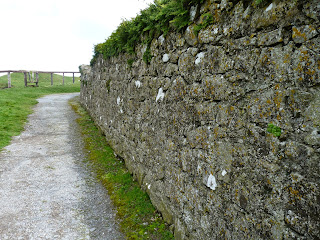
Friday morning we headed west to Kerry County. On our way we stopped in Cashel to visit the Rock of Cashel. The Rock of Cashel was more formally known as St. Patrick's Rock. It was the site of the
conversion of Aenghus the King of Munster by St. Patrick in the 5th
century AD.
The grounds around the buildings are home to an extensive graveyard, which includes a number of beautiful high crosses. The entire plateau atop the rock is walled.
The oldest and tallest of the buildings is the well preserved round tower
(90 feet) which dates back around 1100. The tower was built using the dry stone method. Modern conservationists have filled in some of the tower with mortar for safety reasons. Only the roof has been rebuilt, in the 19th century.



Cormac's Chapel was consecrated in 1134 and is the most important building. Begun in 1127, it is a very sophisticated structure that has two square towers flanking the east end, which may suggest Germanic influences.
St. Patrick's Cross was created in Ireland during the 12th Century. The Cross is built in the Latin Style, which had two pillars running parallel with the main body of the cross, with supports at either side. One face of the monument depicts Christ's crucifixion, while the other shows the image of an abbot or bishop, perhaps representing Patrick himself. The sandstone Cross is kept in the undercroft of the Vicar's Choral. This concrete replica now stands where the original once stood. The interior of the base is hollow to a depth of about a foot. This hollow may have acted as a hiding place for relics or other valuables.
Tombs

The views of the countryside were amazing.


The remains of the cross still remain on the ground.
Hore Abbey was founded in 1266 and given to the Cistercian monks from Mellifont Abbey in 1272 by David McCarvill, Archbishop of nearby Cashel. Tradition says that McCarvill expelled the Benedictine monks after he had a dream that they were about to kill him. He endowed the Abbey generously with land, mills and other buildings previously belonging to the town, which caused local resentment. Most of the abbey was built in the thirteenth century, however many changes were made to the buildings in the fifteenth century including the addition of the tower. The ruins are now surrounded by fields of sheep and cattle and can be accessed by the public
This path led us down the rock and into town.
We ate lunch at Fahy's. It was crazy busy with school age children. My guess is that it's the local hangout for high school children after school. Everyone was drinking lemonade and chatting about their day.I ate a wonderful seafood chowder. It was a perfect lunch for a chilly day.

We enjoyed the rest of our drive and arrived in Killarney about 4:00.




























Comments
Post a Comment